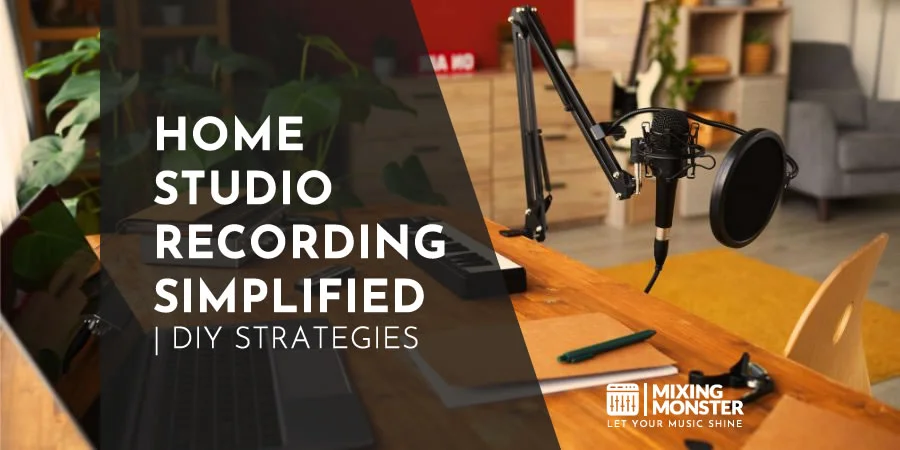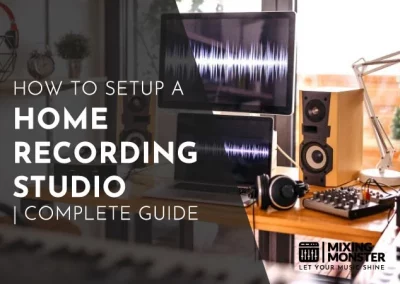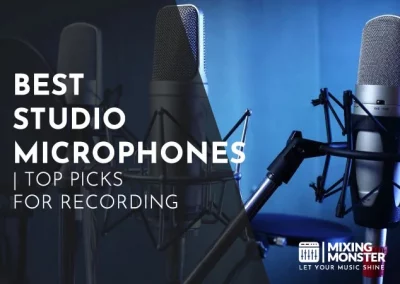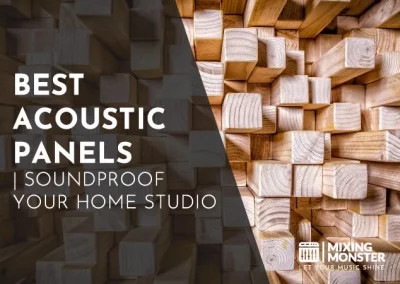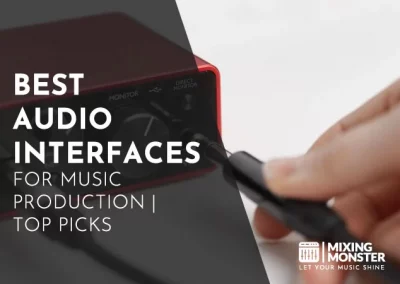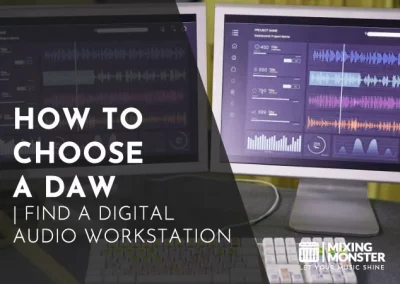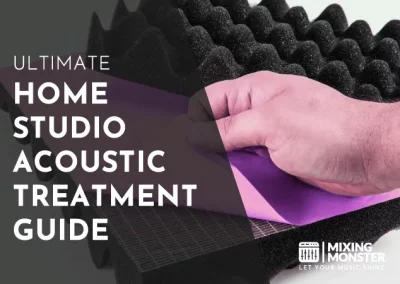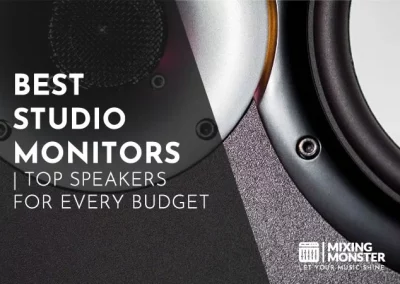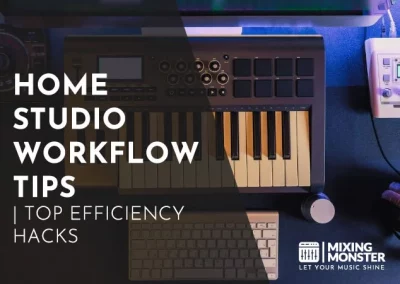Home > Blog > Studio Gear > Home Studio Gear
Disclosure: Some of the links below are affiliate links, meaning that at no additional cost to you, we will receive a commission if you click through and make a purchase. Read our full affiliate disclosure here.
Transforming a corner of your home into a recording studio has never been more attainable. With a mix of technology and creativity, you can create a space where music and podcasts come to life. Setting up your own home studio recording space opens a world of possibilities, enabling you to produce professional-quality tracks from the comfort of your living quarters.
Home studio recording is both an art and a science, consisting of essential gear, acoustic treatments, and ergonomic considerations to ensure a suitable environment for capturing sound. Key components include a reliable computer, an audio interface, microphones, monitors, DAW (Digital Audio Workstation) software, and cables to connect everything. Attention to room acoustics significantly improves the quality of your recordings, making sound treatment just as crucial as the equipment.
This article provides a roadmap to navigate the complexities of equipment selection, room setup, and recording techniques. You’ll learn about the must-have tools and discover how to maximize their potential. With practical advice that spans bare essentials to advanced equipment upgrades, you’ll be well-equipped to fine-tune your recordings and bring your auditory visions to fruition.
KEY TAKEAWAYS:
- Home studio recording enables you to produce high-quality audio from home.
- Essential elements include gear, room acoustics, and ergonomic setup.
- The article guides us through equipment selection and effective recording techniques.
Table Of Contents
1. Planning Your Home Recording Studio
2. Essential Equipment For Your Home Recording Studio
3. Home Recording Studio Acoustic Treatment And Setup
4. Home Recording Studio Software And DAWs
5. Home Studio Recording Techniques
6. MIDI Controllers And Instruments
7. Connectivity And Cables
8. Home Recording Studio Ergonomics
9. Advanced Home Recording Studio Equipment And Upgrades
10. Computer And Hardware For A Home Recording Studio
11. Start Building Your Home Recording Studio
12. FAQ

1. Planning Your Home Recording Studio
Before creating your home studio, it’s vital to grasp some fundamental concepts, select an appropriate room, and have a realistic budget for acquiring equipment and designing the space.
Understanding Home Studio Recording Basics
To start your journey in home studio recording, familiarize yourself with the essential equipment you’ll need. This includes an audio interface, microphones, studio monitors, headphones, and recording software (DAW).
Each tool plays a crucial role in the quality of your recordings, with the audio interface acting as the heart of your setup by converting analog signals into digital data for your computer to process.
Choosing The Right Room For Your Home Recording Studio
The acoustics and size of the room are paramount when setting up your studio. Look for a quiet room with minimal external noises; this will substantially affect your recording quality.
The guide from HachiHive emphasizes the importance of room selection. It advises you to opt for a space with soundproofing that is achievable and whose shape minimizes echoes and standing waves.
Home Recording Studio Budgeting And Costs
Establishing a budget is essential for the economical setup of your home studio. Costs can vary widely, from affordable basic setups to professional-grade equipment. Outline your financial limits and allocate funds towards the essential equipment versus the nice-to-haves.
Consider investing in essentials like acoustic treatment and reliable gear when designing your studio space. Remember to account for hidden costs such as cables, stands, and software licenses. When on a strict budget, prioritize purchases that influence the sound quality over aesthetic items.
2. Essential Equipment For Your Home Recording Studio
Setting up a home recording studio requires key equipment to ensure high-quality sound production. It’s crucial to start with the proper foundation and build up your studio with the essential tools for your recording needs.
Selecting A Computer
Your computer is the backbone of your home studio, and you are tasked with running your Digital Audio Workstation (DAW). Choose a computer with a powerful processor, ample RAM, and sufficient storage for multi-track recording and editing for optimal performance.
- Processor:
Aim for a quad-core processor or better. - RAM:
8GB is the minimum, but 16GB or more is preferred. - Storage:
SSDs offer faster data access speeds, which help with load times and overall performance.
Audio Interface Essentials
An audio interface acts as the bridge between your microphones and your computer. It converts analog signals into digital data and vice versa. When choosing an audio interface, consider:
- Input/Output:
The number of inputs and outputs accommodates your recording needs. - Compatibility:
Ensure it’s compatible with your DAW and computer’s connections.
Microphone Selection
Different microphones serve various purposes in a home recording environment. Start with at least one high-quality condenser microphone for vocals and an instrument mic for versatility.
- Condenser Microphones:
Ideal for capturing vocal subtleties and high frequencies. - Dynamic Microphones:
Better suited for louder sources like electric guitar amps and drums.
Monitoring Systems
Accurate monitoring is pivotal for mixing and mastering. For a detailed sound experience, invest in a set of quality studio monitors and headphones.
- Studio Monitors:
Provide a flat frequency response for an unbiased sound. - Headphones:
Closed-back headphones are fabulous for recording, while open-back headphones may be better for mixing.
3. Home Recording Studio Acoustic Treatment And Setup
Creating an optimal home recording environment hinges on meticulous acoustic treatment and setup. This section will guide you through enhancing room acoustics, selecting effective treatment materials, and positioning monitors precisely for a superior sound experience.
Room Acoustics
Your home studio’s acoustics significantly influence the quality of your recordings. First reflection points are crucial as they are the initial spots where sound waves bounce off surfaces, reaching your ears shortly after the direct sound.
Ensuring these points are well-managed for vocal recordings is essential for precise and accurate sound capture. Acoustic panels and bass traps are commonly employed to treat these reflection points, with bass traps positioned in corners where low-frequency build-ups are typical.
Treatment Materials
The materials you employ for acoustic treatment play a pivotal role in controlling your studio’s sound. High-quality acoustic panels absorb mid- to high-frequency frequencies, preventing excessive reverberation and ensuring vocals sound more focused.
Bass traps address low-frequency issues, which are more challenging to manage due to their longer wavelengths. Diffusers are another important treatment material; they scatter sound waves, promoting a more balanced soundscape without over-dampening your space.
- Acoustic Panels:
It is usually made of foam or fiberglass and applied on walls and ceilings. - Bass Traps:
Dense materials like rockwool are placed in the room corners. - Diffusers:
Typically, wooden structures are placed opposite your sound source to disperse reflections evenly.
Monitor Positioning
Precise monitor positioning is fundamental for accurate sound reproduction in your home studio. Position your speakers to form an equilateral triangle with your listening position, creating the ideal ‘sweet spot.’
Ensure the tweeters are at ear level and avoid placing monitors directly on desks or against walls, which can cause sound coloration due to reflections and resonances.
To further optimize the setup, consider stands or pads designed to decouple the monitors from surfaces, resulting in cleaner sounds and less bass build-up.
- Monitor Height:
Tweeters at ear level. - Monitor Angle:
Speakers are directed slightly inward toward the listener. - Decoupling:
Use isolation stands or pads to minimize vibrations.
4. Home Recording Studio Software And DAWs
In home recording, Digital Audio Workstations (DAWs) are the backbone, serving as the centralized software for recording, editing, mixing, and producing audio.
Now, let’s focus on selecting the right DAW, some of the leading options in the market, and the importance of additional software like plugins and virtual instruments.
Choosing A DAW
Your Digital Audio Workstation is more than just software; it’s a critical tool that should align with your workflow preferences and your projects’ technical demands.
Selecting a DAW often involves considering factors such as compatibility with your audio interface, the types of recording (e.g., MIDI, live instruments), and the genres you aim to produce.
Sprawling feature sets in DAWs like Pro Tools might cater to professionals needing advanced capabilities. At the same time, options like Reaper offer affordability and scalability without compromising essential features.
Popular DAWs Overview
- Pro Tools:
Often regarded as the industry standard, Pro Tools excels in mixing and editing for high-level production tasks. - Logic Pro:
Exclusively for Mac users, Logic Pro provides a comprehensive suite of tools tailored towards musicians and composers. - Ableton Live:
Known for its unique session view, Ableton Live is a favorite among live performers and electronic music creators due to its loop-based sequencing and MIDI capabilities. - Cubase:
Cubase is a powerhouse for composers, offering extensive MIDI editing tools and intuitive workflows. - Studio One:
A rising star for its drag-and-drop functionality and modern interface, it is particularly user-friendly for newcomers.
Plugins And Virtual Instruments
Your DAW’s built-in tools are just the beginning. To expand your sonic palette, incorporate plugins, virtual instruments, and software-based tools that emulate a wide range of sound-producing hardware or provide creative effects or advanced mixing functions.
These additions, from virtual synthesizers to dynamic processing plugins, are invaluable for achieving professional-sounding mixes. Be mindful of your DAW’s plugin format compatibility, such as VST or AU, to ensure seamless integration into your projects.

5. Home Studio Recording Techniques
Understanding how to capture vocals and instruments in your home studio effectively is crucial to achieving professional-sounding recordings. Utilize the right microphone and technique to ensure clarity and quality in your productions.
Recording Vocals
When recording vocals, a condenser microphone is needed because of its sensitivity and wider frequency response. To mitigate plosives, place a pop filter a few inches from the mic. Acoustic treatment around the recording area can greatly reduce unwanted echo and reflections, leading to a cleaner recording.
Miking Instruments
- Drums:
Use a combination of dynamic and condenser microphones. A dynamic mic such as the Shure SM57 is great for snare drums, while large-diaphragm condensers can capture the nuances of cymbals. - Acoustic Guitar:
A small diaphragm condenser 6-12 inches from the 12th fret achieves a balanced sound. - Electric Guitar:
Miking the amplifier with a dynamic microphone close to the speaker cone can capture the amp’s character.
Home Recording Tips
- Microphone placement is critical. Experiment with distance and angles to find the sweet spot, especially for instruments.
- Understanding polar patterns is essential for mic placement. A cardioid pattern reduces room noise and allows for a tighter focus on the sound source.
- Ensure your microphone input levels are set correctly; too high can cause clipping, and too low may introduce noise during post-processing.
6. MIDI Controllers And Instruments
Essential to modern music production, MIDI controllers extend your creativity and ease of composing within a digital audio workstation (DAW). Let’s explore how MIDI works and how to choose and integrate the suitable MIDI controller for your home studio needs.
MIDI Basics
MIDI, which stands for Musical Instrument Digital Interface, is a technical standard that allows electronic musical instruments, computers, and other equipment to communicate, control, and synchronize. MIDI does not transmit audio – it sends information about how music is played, such as notes, timing, velocity, and other expressive data.
Choosing A MIDI Controller
When selecting a MIDI controller, consider the following types based on your needs:
- MIDI Keyboard:
Ideal for playing melodies, chords, and basslines. Available in various sizes, from mini 25-key to full 88-key ranges. - Pad Controllers:
Great for percussion and sample triggering. - Control Surfaces:
Provide knobs, faders, and switches for tactile control over your DAW’s mixer, effects, and instruments.
Features to consider:
- Weight/Action:
Synth action is lighter, while hammer action simulates a traditional piano. - Key Count:
More keys offer a wider range but consider your space too. - Pads and Knobs:
For extra control over beats and sounds. - Connectivity:
USB is standard, but some offer MIDI for hardware synths.
Integrating MIDI Controllers With DAWs
To enhance your workflow, ensure your MIDI controller is compatible with your DAW:
- Installation:
Most are plug-and-play via USB. Install any necessary drivers your device may need. - Mapping:
Customize how your controller interacts with your DAW. Many come pre-mapped for popular software. - Performance:
Test latency and responsiveness. Aim for minimal delay for a more natural playing feel.
7. Connectivity And Cables
Understanding the ins and outs of connectivity and the suitable types of cables is crucial for setting up your home studio. Selecting the right cables for your equipment ensures high-quality sound transmission and efficient workflow.
USB And Audio Connections
Your home studio setup significantly depends on the types of USB and audio connections available. Most audio interfaces now offer USB connectivity, which translates digital signals from your computer into analog signals that your studio monitors can understand. It’s essential to be aware that there are different USB cables, such as USB-A, USB-B, and USB-C, each serving different devices and purposes.
XLR cables are a staple for professional audio recording. They are designed with a balanced three-pin configuration that minimizes noise and interference, making them ideal for microphones and connecting to high-end audio interfaces. Remember, these cables are not interchangeable with others, such as TS or TRS, which have different connector types and uses.
Cable Management
Effective cable management helps prevent accidents and ensures your studio remains organized and functional. Consider these tips:
- Label your cables. Use color-coded bands or labels to identify your cables quickly.
- Organize cables by length and type. Keep them neatly coiled when not in use.
- Use cable ties to secure cables together and prevent tangling.
- Route cables sensibly, avoiding high-traffic areas to reduce the risk of tripping or disconnection.
- Cable hooks or trays can run cables along walls and under desks, maintaining an orderly studio space.
8. Home Recording Studio Ergonomics
Ergonomics plays a pivotal role in your home studio, affecting your comfort, long-term health, and productivity. To ensure an optimal working environment, it’s important to select the appropriate desk, chair, and other furniture and organize your space effectively.
Choosing A Desk
Your desk is the centerpiece of the studio. Opt for a height between 28 and 30 inches to match standard chair heights and maintain a comfortable arm angle.
Ensure that your arms can rest on the desk, forming a 90-degree angle, which encourages relaxed shoulders and an upright posture, vital for avoiding strain during long sessions. Prioritize desks with adjustable height for a more customized and ergonomic setup.
For instance, a guide on ergonomic desks for home recording studios specifies that matching the desk height to the user’s chair and physical build is crucial for comfort.
Chair And Furniture
Selecting the right chair can dramatically improve your studio experience. Your chair should offer lumbar support, be height adjustable, and allow easy movement around your studio.
As noted in a home studio ergonomics guide, ergonomics’ impact on health underscores the importance of good seating. When it comes to furniture, choose pieces that complement the desk and chair ergonomically, including monitor stands at eye level and reachable racks for your equipment without overreaching.
Organizing Studio Space
The layout of your home studio should facilitate ease of movement and minimize physical strain. Arrange your equipment so the most-used items are within arm’s reach. Monitors should be positioned to prevent neck strain, ideally at eye level and an arm’s length away.
Have enough room for your legs under the desk, and use cable management solutions to prevent tripping hazards. An organized studio space not only improves ergonomics but also enhances workflow efficiency.
9. Advanced Home Recording Studio Equipment And Upgrades
Investing in high-quality equipment can significantly improve your sound when building an advanced home recording studio. From high-end microphones to outboard gear, the right upgrades can capture pristine audio and give you more control over your sound.
High-End Microphones
Upgrading your studio with high-end microphones is essential for capturing detailed and rich audio. Consider microphones with variable polar patterns to give you versatility in your recording.
For example, a premium large-diaphragm condenser microphone, with its wide frequency response and high sensitivity, can greatly enhance vocal recordings.
- Neumann U87:
Renowned for its clarity and well-rounded sound, it is perfect for vocals and acoustic instruments. - Shure SM7B:
A dynamic microphone with a smooth, flat, wide-range frequency response suitable for music and speech.
Outboard Equipment
Incorporating outboard equipment like preamps, compressors, and equalizers can take your studio’s sound to a professional level. This rack gear gives you more precise control over audio signals, often adding warmth and character that’s hard to replicate with software alone.
- Preamps:
- Focusrite Scarlett:
Offers a clean gain, with some models providing Air mode to emulate the classic Focusrite ISA preamp sound. - Neve 1073:
It is widely considered a studio staple known for adding desirable coloration and warmth to the signal.
- Focusrite Scarlett:
- Compression:
- Empirical Labs Distressor:
This is an extremely versatile unit capable of subtle to aggressive compression and works well with various sources.
- Empirical Labs Distressor:
- Audio Effects:
- Reverb And Delay:
High-quality outboard reverb or delay units can provide lush soundscapes that enrich your tracks. - Lexicon PCM92:
It is known for premium reverb effects and a range of high-end algorithms that can elevate your music.
- Reverb And Delay:
In the realm of outboard gear, remember that RAM isn’t a concern as it is with digital audio workstations and plugins. However, ensuring your computer has sufficient RAM to handle large sessions is still important, especially when you’re integrating hardware with software tools for a seamless workflow.
10. Computer And Hardware For A Home Recording Studio
The computer and hardware specifications are crucial when setting up your home recording studio. With the right components, you’ll ensure your system operates smoothly during recording and production processes.
Operating System Compatibility
Your choice of computer, whether a Mac or Windows PC, affects the recording software you can use. Mac computers are often chosen for their easy integration with professional software, while Windows PCs offer more flexibility in hardware upgrades and software compatibility.
Make sure your chosen DAW (Digital Audio Workstation) is supported by the computer’s operating system you select.
Mac:
- macOS 10. X or later for modern DAW compatibility
- Robust ecosystem for audio production
Windows:
- Windows 10 or later recommended
- Broad compatibility with a range of DAWs
Hardware Requirements
CPU:
- Minimum: Quad-core processor
- Recommended: Hexa-core or higher for better processing power
RAM:
- Minimum: 8GB for basic tasks
- Recommended: 16GB or more for heavy workloads
Storage:
- SSD (Solid State Drive) for faster file access and software loading
- Minimum: 256GB to store your OS and DAW
- Recommended: 500GB or larger, plus an external drive for audio files
Make sure the laptop or desktop you choose can handle music production demands. The CPU must be capable of processing multiple tracks and plugins without latency. Adequate RAM is essential for smooth multitasking and running large sessions. Your computer needs enough storage not just for software but also for large audio files and samples.
11. Start Building Your Home Recording Studio
Embarking on building your home recording studio can be an exciting endeavor. Ensure you have a concise plan that includes essential equipment and proper room treatment for optimal sound.
Key Takeaways To Get Started In Home Studio Recording
- Choose An Appropriate Room:
Acoustics matters, so pick a quiet room with minimal noise interference. A bedroom or a spare room can often be a good choice. - Invest In A Reliable Computer:
Your computer acts as the command center for your recording studio; hence, it must be powerful enough to handle audio processing. - Acquire A Quality DAW:
A Digital Audio Workstation (DAW) is your primary software for recording, editing, and mixing music. - Select A Suitable Audio Interface:
This device will bridge your instruments, microphones, and computer. - Purchase Studio Monitors And Headphones:
Neutral-sounding studio monitors and headphones are critical for accurate audio evaluation. - Get Your Hands On Microphones:
You may need several microphones depending on what you plan to record. - Invest In Cables And Stands:
Ensure you have all the cables for connectivity and stand for positioning microphones or other equipment. - Implement Sound Treatment:
Properly soundproof your space to manage acoustics and noise control. - Arrange Your Workspace:
An ergonomic desk and chair will keep you comfortable during long sessions. - Understand Your Equipment:
Take the time to learn how each piece of gear works to get the best results from your setup.
Happy home studio recording!
12. FAQ
1) What essential equipment is required to set up a home recording studio?
To start your home studio, you need a reliable computer, an audio interface, a good-quality microphone, studio monitors, headphones, and recording software. Each piece plays a critical role in capturing and refining your sound.
2) What is the average cost to establish a basic home recording studio?
The cost can vary widely, from a few hundred dollars for a basic setup to several thousand dollars. It largely depends on the quality of the components you select and whether you opt for entry-level or professional-grade equipment.
3) Is it possible to achieve professional studio quality with a home setup?
With the right equipment and acoustic treatment, a home studio can produce high-quality recordings. However, achieving professional studio quality also depends on your recording skills and knowledge of audio editing and mixing techniques.
4) How can I record a song in my home studio with optimal sound quality?
Ensure your recording space is acoustically treated to reduce unwanted echoes and reverb. Use a high-quality microphone and set appropriate levels on your audio interface to avoid clipping. Investing in good studio monitors will aid in accurate sound reproduction for mixing.
5) Which home recording studio kit is recommended for beginners?
For beginners, look for a home recording studio kit with an audio interface, a microphone, headphones, and basic recording software. These kits offer a solid foundation and are available at different price points suited to various budgets.
6) What are the important steps involved in creating a functional home studio setup?
The first step is planning your space. Consider factors like room acoustics and lighting. After assembling the essential hardware and software, learn to use them effectively for recording, mixing, and mastering. Regular maintenance and upgrades will keep your studio functioning optimally.

